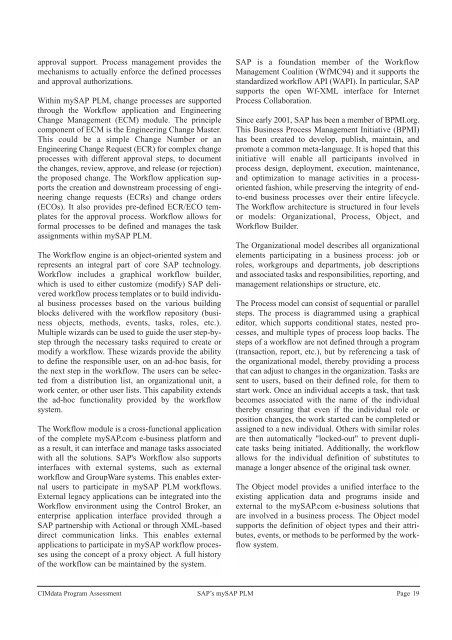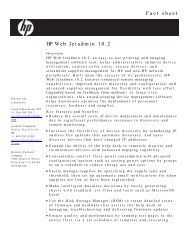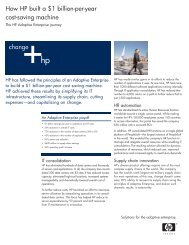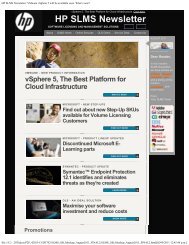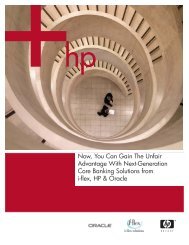CIMdata review on SAP's PLM cPDm program (PDF) - Large ...
CIMdata review on SAP's PLM cPDm program (PDF) - Large ...
CIMdata review on SAP's PLM cPDm program (PDF) - Large ...
You also want an ePaper? Increase the reach of your titles
YUMPU automatically turns print PDFs into web optimized ePapers that Google loves.
approval support. Process management provides the<br />
mechanisms to actually enforce the defined processes<br />
and approval authorizati<strong>on</strong>s.<br />
Within mySAP <strong>PLM</strong>, change processes are supported<br />
through the Workflow applicati<strong>on</strong> and Engineering<br />
Change Management (ECM) module. The principle<br />
comp<strong>on</strong>ent of ECM is the Engineering Change Master.<br />
This could be a simple Change Number or an<br />
Engineering Change Request (ECR) for complex change<br />
processes with different approval steps, to document<br />
the changes, <str<strong>on</strong>g>review</str<strong>on</strong>g>, approve, and release (or rejecti<strong>on</strong>)<br />
the proposed change. The Workflow applicati<strong>on</strong> supports<br />
the creati<strong>on</strong> and downstream processing of engineering<br />
change requests (ECRs) and change orders<br />
(ECOs). It also provides pre-defined ECR/ECO templates<br />
for the approval process. Workflow allows for<br />
formal processes to be defined and manages the task<br />
assignments within mySAP <strong>PLM</strong>.<br />
The Workflow engine is an object-oriented system and<br />
represents an integral part of core SAP technology.<br />
Workflow includes a graphical workflow builder,<br />
which is used to either customize (modify) SAP delivered<br />
workflow process templates or to build individual<br />
business processes based <strong>on</strong> the various building<br />
blocks delivered with the workflow repository (business<br />
objects, methods, events, tasks, roles, etc.).<br />
Multiple wizards can be used to guide the user step-bystep<br />
through the necessary tasks required to create or<br />
modify a workflow. These wizards provide the ability<br />
to define the resp<strong>on</strong>sible user, <strong>on</strong> an ad-hoc basis, for<br />
the next step in the workflow. The users can be selected<br />
from a distributi<strong>on</strong> list, an organizati<strong>on</strong>al unit, a<br />
work center, or other user lists. This capability extends<br />
the ad-hoc functi<strong>on</strong>ality provided by the workflow<br />
system.<br />
The Workflow module is a cross-functi<strong>on</strong>al applicati<strong>on</strong><br />
of the complete mySAP.com e-business platform and<br />
as a result, it can interface and manage tasks associated<br />
with all the soluti<strong>on</strong>s. <strong>SAP's</strong> Workflow also supports<br />
interfaces with external systems, such as external<br />
workflow and GroupWare systems. This enables external<br />
users to participate in mySAP <strong>PLM</strong> workflows.<br />
External legacy applicati<strong>on</strong>s can be integrated into the<br />
Workflow envir<strong>on</strong>ment using the C<strong>on</strong>trol Broker, an<br />
enterprise applicati<strong>on</strong> interface provided through a<br />
SAP partnership with Acti<strong>on</strong>al or through XML-based<br />
direct communicati<strong>on</strong> links. This enables external<br />
applicati<strong>on</strong>s to participate in mySAP workflow processes<br />
using the c<strong>on</strong>cept of a proxy object. A full history<br />
of the workflow can be maintained by the system.<br />
SAP is a foundati<strong>on</strong> member of the Workflow<br />
Management Coaliti<strong>on</strong> (WfMC94) and it supports the<br />
standardized workflow API (WAPI). In particular, SAP<br />
supports the open Wf-XML interface for Internet<br />
Process Collaborati<strong>on</strong>.<br />
Since early 2001, SAP has been a member of BPMI.org.<br />
This Business Process Management Initiative (BPMI)<br />
has been created to develop, publish, maintain, and<br />
promote a comm<strong>on</strong> meta-language. It is hoped that this<br />
initiative will enable all participants involved in<br />
process design, deployment, executi<strong>on</strong>, maintenance,<br />
and optimizati<strong>on</strong> to manage activities in a processoriented<br />
fashi<strong>on</strong>, while preserving the integrity of endto-end<br />
business processes over their entire lifecycle.<br />
The Workflow architecture is structured in four levels<br />
or models: Organizati<strong>on</strong>al, Process, Object, and<br />
Workflow Builder.<br />
The Organizati<strong>on</strong>al model describes all organizati<strong>on</strong>al<br />
elements participating in a business process: job or<br />
roles, workgroups and departments, job descripti<strong>on</strong>s<br />
and associated tasks and resp<strong>on</strong>sibilities, reporting, and<br />
management relati<strong>on</strong>ships or structure, etc.<br />
The Process model can c<strong>on</strong>sist of sequential or parallel<br />
steps. The process is diagrammed using a graphical<br />
editor, which supports c<strong>on</strong>diti<strong>on</strong>al states, nested processes,<br />
and multiple types of process loop backs. The<br />
steps of a workflow are not defined through a <strong>program</strong><br />
(transacti<strong>on</strong>, report, etc.), but by referencing a task of<br />
the organizati<strong>on</strong>al model, thereby providing a process<br />
that can adjust to changes in the organizati<strong>on</strong>. Tasks are<br />
sent to users, based <strong>on</strong> their defined role, for them to<br />
start work. Once an individual accepts a task, that task<br />
becomes associated with the name of the individual<br />
thereby ensuring that even if the individual role or<br />
positi<strong>on</strong> changes, the work started can be completed or<br />
assigned to a new individual. Others with similar roles<br />
are then automatically "locked-out" to prevent duplicate<br />
tasks being initiated. Additi<strong>on</strong>ally, the workflow<br />
allows for the individual definiti<strong>on</strong> of substitutes to<br />
manage a l<strong>on</strong>ger absence of the original task owner.<br />
The Object model provides a unified interface to the<br />
existing applicati<strong>on</strong> data and <strong>program</strong>s inside and<br />
external to the mySAP.com e-business soluti<strong>on</strong>s that<br />
are involved in a business process. The Object model<br />
supports the definiti<strong>on</strong> of object types and their attributes,<br />
events, or methods to be performed by the workflow<br />
system.<br />
<str<strong>on</strong>g>CIMdata</str<strong>on</strong>g> Program Assessment SAP’s mySAP <strong>PLM</strong> Page 19


